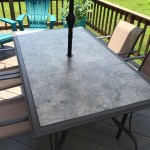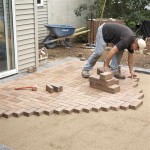How To Create A Patio: A Comprehensive Guide
Creating a patio can significantly enhance the value and enjoyability of a property, providing an outdoor space for relaxation, entertainment, and dining. A well-designed and constructed patio offers an extension of the home's living area, seamlessly blending indoor and outdoor spaces. This article provides a detailed guide on how to create a patio, encompassing planning, design considerations, material selection, and construction steps.
Planning and Design Considerations
The initial phase of patio creation involves meticulous planning and thoughtful design. This foundational stage dictates the overall functionality, aesthetics, and longevity of the finished patio. Neglecting this initial stage can result in a patio that fails to meet the intended needs and may require costly modifications later.
First and foremost, the intended use of the patio should be clearly defined. Will it primarily serve as a dining area, a relaxation space, an entertainment zone, or a combination of these? Understanding the primary function guides the size, layout, and features incorporated into the design. A dining patio necessitates sufficient space for a table and chairs, while a relaxation patio might prioritize comfortable seating arrangements and shade structures.
Next, the available space must be carefully assessed. Measure the area where the patio will be located, taking into account any existing structures, landscaping features, and property lines. Consider the orientation of the patio in relation to the sun. A south-facing patio will receive the most sunlight, which may be desirable in cooler climates but necessitate shade solutions in hotter regions. An east-facing patio will benefit from morning sun, while a west-facing patio will experience afternoon and evening sun. The placement of the patio should also consider prevailing winds and any potential noise sources.
Developing a detailed design plan is crucial. This plan should include the dimensions of the patio, the placement of any features such as built-in seating, fire pits, or water features, and the planned landscaping. Graphical representations, such as sketches or computer-aided designs (CAD), can be invaluable in visualizing the final product and identifying potential issues before construction begins. Consider the overall aesthetic of the house and surrounding landscape when designing the patio. The patio should complement the existing architecture and blend harmoniously with the natural environment. Pay attention to the shape and proportions of the patio, ensuring that it feels balanced and inviting.
Permits and regulations should also be investigated. Many municipalities require permits for patio construction, particularly if the patio is attached to the house or involves significant excavation. Check with the local building department to determine the specific requirements in the area. Compliance with zoning regulations, building codes, and homeowners association rules is essential to avoid potential fines or legal issues.
Finally, budgeting accurately is crucial for a successful patio project. Estimate the costs of materials, labor (if hiring contractors), permits, and landscaping. Obtain quotes from multiple suppliers and contractors to ensure competitive pricing. Allocate a contingency fund for unexpected expenses, as unforeseen issues often arise during construction.
Material Selection and Preparation
The choice of materials significantly impacts the appearance, durability, and cost of the patio. A wide range of options is available, each with its own advantages and disadvantages. Careful consideration should be given to the aesthetic preferences, budget constraints, and environmental conditions when selecting materials.
Concrete is a popular choice due to its versatility, affordability, and durability. It can be poured in place, precast into pavers, or stamped with various patterns and textures to mimic the look of natural stone. Concrete is relatively low-maintenance and can withstand heavy foot traffic and harsh weather conditions. However, it can be susceptible to cracking and staining if not properly sealed. Stamped concrete offers a wider range of aesthetic options, allowing for customization and a more visually appealing surface.
Natural stone, such as flagstone, slate, and limestone, offers a timeless and elegant look. It is highly durable and can withstand extreme weather conditions. Natural stone is also slip-resistant and adds a touch of natural beauty to the patio. However, it tends to be more expensive than concrete and requires more labor to install. The irregular shapes and sizes of natural stone can also make installation more challenging.
Brick is another classic choice for patios, offering a warm and inviting aesthetic. It is durable, relatively affordable, and easy to install. Brick pavers come in a variety of colors and patterns, allowing for creative design possibilities. However, brick can be susceptible to fading and cracking over time, particularly in colder climates with freeze-thaw cycles. Proper sealing and maintenance can help extend the lifespan of a brick patio.
Wood decking is a popular choice for elevated patios or decks, providing a warm and natural feel. Wood is relatively easy to work with and can be customized to fit any space. However, wood requires regular maintenance, including staining or sealing, to prevent rot and decay. Composite decking is a low-maintenance alternative to wood, offering the look and feel of wood without the need for staining or sealing. Composite decking is made from recycled materials and is highly resistant to rot, decay, and insect damage. However, it tends to be more expensive than wood.
Once the materials have been selected, proper preparation is essential for ensuring a stable and long-lasting patio. This includes excavating the area to the desired depth, installing a base of compacted gravel, and leveling the surface. The depth of the excavation will depend on the type of material being used and the soil conditions. A layer of compacted gravel provides a stable base for the patio and helps to improve drainage. The surface should be carefully leveled to ensure a smooth and even patio.
For concrete patios, forms should be constructed to contain the concrete during pouring and curing. The forms should be sturdy and accurately aligned to ensure a straight and even edge. Reinforcement, such as wire mesh or rebar, should be added to the concrete to increase its strength and durability. For paver patios, a layer of sand is typically spread over the compacted gravel to provide a level surface for the pavers. The pavers should be carefully laid out in the desired pattern and tapped into place with a rubber mallet.
Construction and Finishing Touches
With the planning and preparation complete, the construction phase can begin. This involves laying the chosen patio material, ensuring proper drainage, and adding the finishing touches that transform the patio into a usable and aesthetically pleasing space.
For concrete patios, the concrete should be poured evenly into the forms and screeded to create a smooth surface. After screeding, the concrete should be floated to further smooth the surface and remove any imperfections. Edges should be carefully rounded to prevent chipping and cracking. The concrete should then be left to cure for several days, during which time it should be kept moist to prevent cracking. Curing compounds can be applied to retain moisture. After curing, the forms can be removed and the concrete can be sealed to protect it from staining and weathering. Stamping can be done while the concrete is still pliable.
For paver patios, the pavers should be laid out in the desired pattern, ensuring that they are tightly butted together. A rubber mallet can be used to gently tap the pavers into place, ensuring that they are level and even. After all the pavers have been laid, a layer of polymeric sand should be swept into the joints to stabilize the pavers and prevent weed growth. The polymeric sand should be activated with water according to the manufacturer's instructions.
Drainage is a crucial consideration for all patios. Proper drainage prevents water from pooling on the surface of the patio, which can lead to cracking, staining, and slippery conditions. The patio should be sloped slightly away from the house to allow water to drain away. Drainage channels or French drains can be installed to further enhance drainage.
Landscaping can significantly enhance the beauty and functionality of the patio. Plants can provide shade, privacy, and visual interest. Consider planting trees, shrubs, and flowers around the perimeter of the patio to create a natural and inviting atmosphere. Container gardening is also a great option for adding greenery to the patio without requiring extensive landscaping. Choose plants that are well-suited to the climate and soil conditions in the area.
Furniture and accessories are essential for creating a comfortable and functional patio. Choose furniture that is durable, weather-resistant, and comfortable. Consider adding outdoor rugs, cushions, and throws to add warmth and style to the patio. Lighting can also enhance the ambiance of the patio, allowing it to be enjoyed even after dark. String lights, lanterns, and spotlights can be used to create a warm and inviting atmosphere. Fire pits or outdoor fireplaces can add a cozy and romantic touch to the patio.
Finally, ongoing maintenance is essential for preserving the beauty and functionality of the patio. Regularly sweep or hose down the patio to remove dirt and debris. Repair any cracks or damage promptly to prevent further deterioration. Seal the patio every few years to protect it from staining and weathering. By following these guidelines, a patio can be created that provides years of enjoyment and enhances the value of the property.

How To Build A Patio In Weekend Finegardening

Building A Patio Landscaping Network

Paver Patios An Inexpensive Guide To A Backyard Makeover

10 Ways To Create An Incredibly Beautiful Patio Or Outdoor Space

How To Build A Diy Covered Patio

Create A Patio For Comfort Interest And Beauty

Create A Diy Pea Gravel Patio The Easy Way City Farmhouse By Jennifer O Brien

Backyard Patio Design Chester Pa Dutchies Stoneworks

How To Create An Outdoor Room The New York Times

How To Create A Cozy Patio Space Little House








